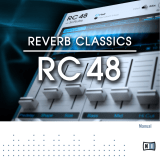
1 Welcome to RC 24
Thank you for downloading RC 24 by Native Instruments.
The following manual will give you an overview of the features of RC 24, as well as explain how
to use the software.
1.1 What Is RC 24?
The RC 24 is a classic reverb with a very special and warm sound that was inspired by a clas-
sic hardware device. The RC 24 brings this renowned unit to your DAW, successfully recreating
its unique, vintage sonic characteristics while greatly extending its usability!
1.2 Manual Conventions
This manual uses particular formatting to point out special facts and to warn you of potential
issues. The icons introducing the following notes let you see what kind of information is to be
expected:
Whenever this exclamation mark icon appears, you should read the corresponding note
carefully and follow the instructions and hints given there if applicable.
This light bulb icon indicates that a note contains useful extra information. This informa-
tion may often help you to solve a task more efficiently, but does not necessarily apply to
the setup or operating system you are using; however, it's always worth a look.
Furthermore, the following formatting is used:
▪ Text appearing in (drop-down) menus (such as Open…, Save as… etc.) and paths to loca-
tions on your hard drive or other storage devices is printed in italics.
▪ Text appearing elsewhere (labels of buttons, controls, text next to checkboxes, etc.) is
printed in light blue. Whenever you see this formatting applied, you will find the same
text appearing somewhere on the screen.
▪ Important names and concepts are printed in bold.
Welcome to RC 24
What Is RC 24?
RC 24 - Manual - 5




























